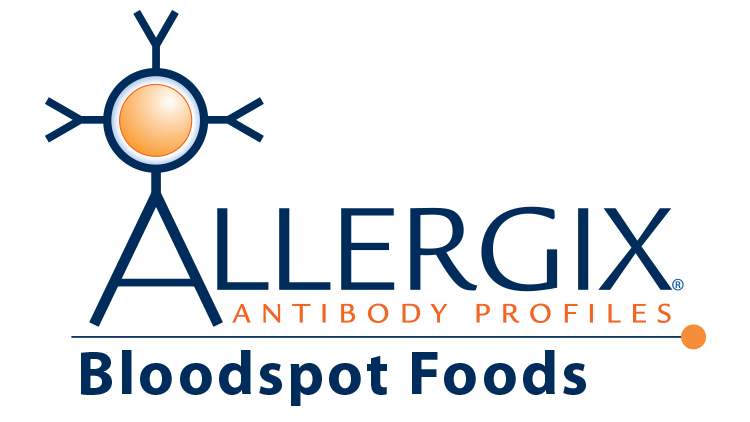Description
Uncover Food-Related Immune Reactions
The Allergix IgG4 Food Antibody Profile is a blood spot test that measures IgG4 antibodies to 30 commonly consumed foods.
When should testing for IgG4 Food Antibodies be considered?
Circulating IgG4 food antibodies are not diagnostic for a specific condition but indicate an immune response to the presence of food antigens. IgG4 antibodies are produced in a delayed hypersensitivity reaction, which can occur one to seven days after exposure to the offending food antigen. These reactions are difficult to detect since there may be no obvious association with the offending food. Commonly reported symptoms for elevated IgG4 responses involve GI tract, skin, nose, and throat. In contrast, the immune response could be a normal response that would not necessarily cause symptoms. Therefore, test results should always be viewed in the context of the overall clinical picture.
Conditions associated with IgG4 food antibodies
- Eosinophilic esophagitis1-3
- Irritable bowel syndrome/ GI symptoms4,5
- Crohn’s disease
Of the 5 classes of antibodies, immunoglobulin G (IgG) is the most abundant circulating antibody, making up 75% of antibodies. The other classes of antibodies include IgE, IgA, IgM, and IgD. IgG has 4 subclasses including IgG1, IgG2, IgG3, and IgG4 making up 66%, 23%, 7%, and 4% of the IgG antigen pool respectively.
IgG4 is unique compared to the other subclasses. It acts as a blocking antibody to the allergy-producingIgE antibody, and with the IgE antibody, is considered part of the Th2 response. Increases in IgG4 levels correlate with improved clinical responses since it blocks the IgEanitbody allergic response; it is involved in establishing immunologic tolerance to that food. IgG4 does not activate complement compared to IgE3.7 Some speculate that IgG4 may be produced initially to attenuate IgE-mediated disease, but ultimately results in a pro-inflammatory process in susceptible atopic hosts.
What advantage does the IgG4 Food Antibody blood spot test offer compared to other diagnostics?
From a simple finger stick, the Bloodspot IgG4 Food Antibodies Profile offers a less invasive alternative to a blood draw in determining IgG4 food reactions.
- Easy to implement in any practice and great option for follow-up testing
- Does not require venipuncture
- Cost-effective testing
- Easy for patients to use at home
- Offers the same levels of precision and reproducibility as standard methods
IgG food antibodies can result in a delayed symptom response to a food.1 Whereas IgE antibodies can result in immediate-hypersensitivity to a substance. It is generally easier for patients and clinicians to identify a food that causes an immediate response. A delayed-response to food may be more challenging to determine, and testing can be helpful. The IgG Food Antibody Assessment evaluates total IgG (1-4) versus only testing for IgG4 and offers a more complete assessment. Clinicians may consider measuring IgG4 in patients with eosinophilic esophagitis.
IgG4 is an allergy blocking antibody, however, scientific societies do not recommend its use in the diagnosis of food allergy. IgG4 testing cannot be substituted for IgE blood testing or skin prick testing for allergy diagnosis.
Other types of adverse food reactions that are not mediated by the immune system are referred to as food intolerances. Food intolerances include lactose intolerance due to lactase enzyme deficiency in the gut; testing is available for suspected lactose intolerance. Testing is not available for all food intolerances. These include vasoactive amines like histamine and tyramine, food additives and preservatives (nitrites, sulfites, MSG, aspartame), salicylates, nightshades, lectins, FODMAPs, oxalates, etc. Since testing is not available for every type of adverse food reaction, the elimination/rechallenge diet remains the gold standard for identification of symptom-producing foods.
Genova’s Methodology
Genova’s Allergix IgG4 antibody test is designed for the semi- quantitative measurement of human IgG4 in whole blood to 30 different foods using an indirect ELISA (enzyme linked immunosorbent assay). The ELISA test, developed by Genova, utilizes a blocking agent to reduce the occurrence of nonspecific antibody antigen interactions. The reported results of the test give each food a numerical value that is ranked from negative to severe.
What can clinicians and patients expect from IgG Food Antibody testing?
In general, clinical management of the patient with food sensitivities involves elimination or rotation of the highly reactive food(s). Often times, clinicians and patients notice improvement of symptoms after diet modification. Patients may be able to tolerate the food in small amounts, without symptoms, after several weeks or months of elimination.



